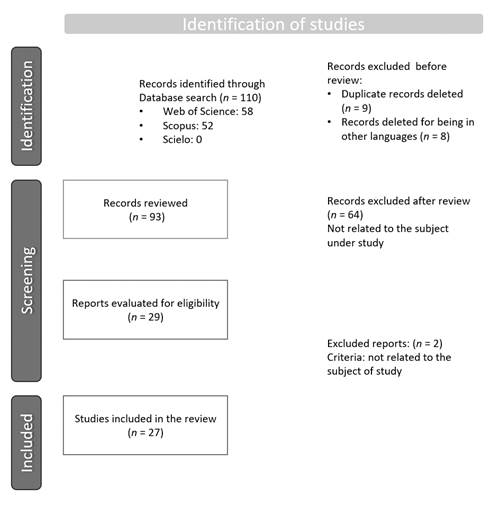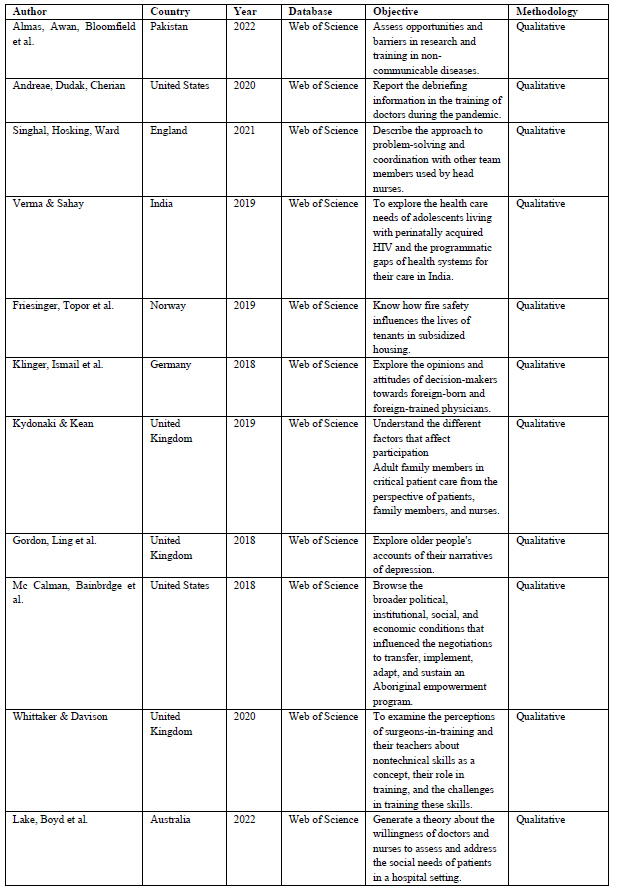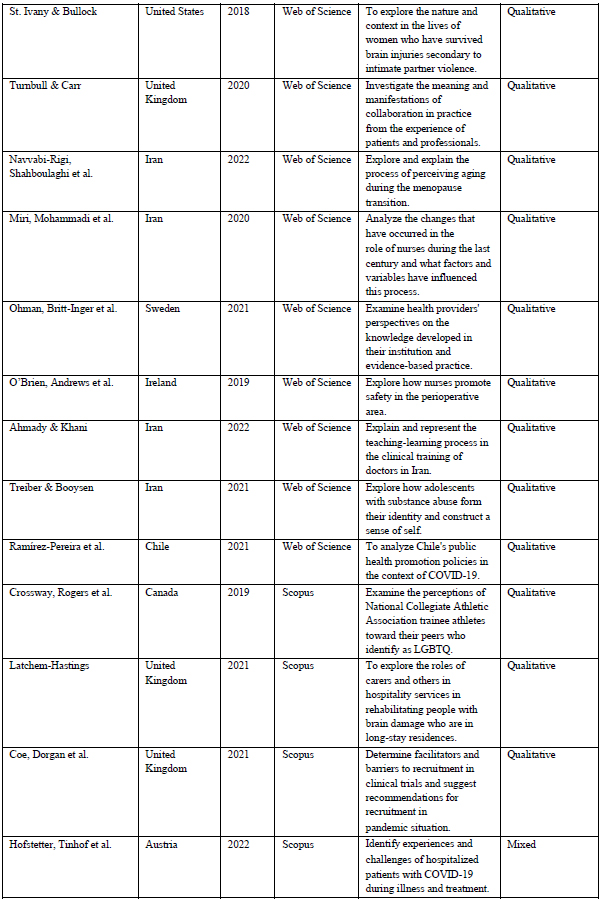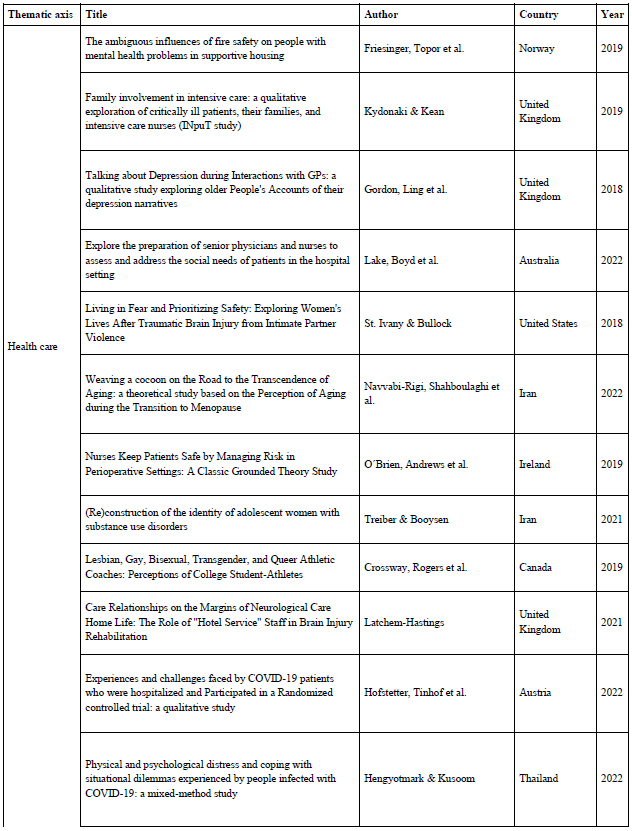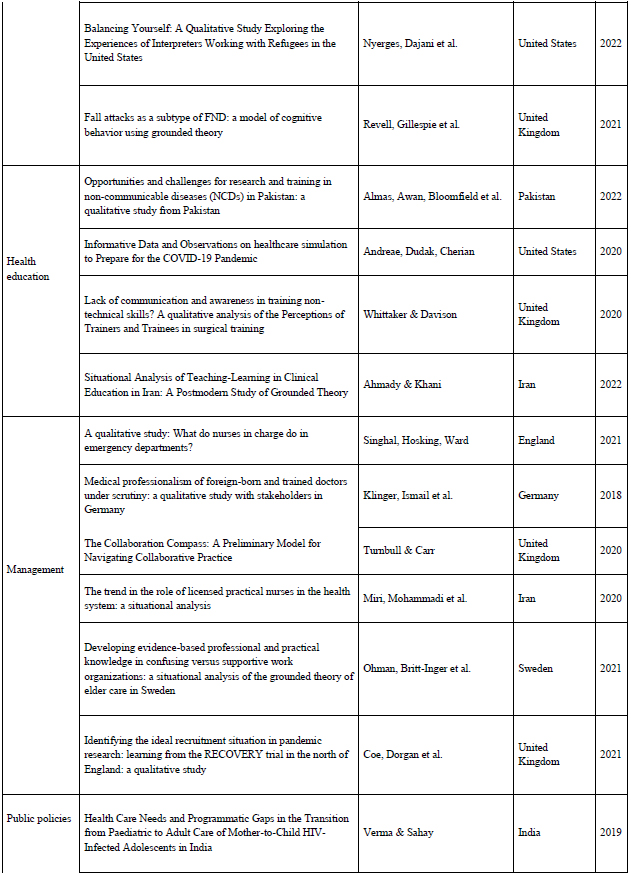Serviços Personalizados
Journal
Artigo
Links relacionados
Compartilhar
Enfermería: Cuidados Humanizados
versão impressa ISSN 1688-8375versão On-line ISSN 2393-6606
Enfermería (Montevideo) vol.12 no.2 Montevideo 2023 Epub 01-Dez-2023
https://doi.org/10.22235/ech.v12i2.3108
Original articles
The situational analysis of grounded theory in health: an integrative review of the postmodern variant of grounded theory
1 Universidad de Chile, Chile, mirliana@uchile.cl
2 Universidad Católica del Uruguay, Uruguay
5 Universidad Católica del Norte, Chile
Introduction:
The complexity of the current era requires considering quantitative and qualitative perspectives, data from different sources, multiple methods, and a melting pot of approaches. To respond to this complexity, situational analysis is presented as a possible method.
Methodology:
An integrative review is presented in relation to the variant of situational analysis, which follows the following steps: 1) problem identification (clearly defined research question and objective); 2) literature search (comprehensive search strategy); 3) data assessment; 4) data analysis (data reduction, visualization, comparison, and conclusions); and 5) presentation of results as well as implications for practice, public policy, and future research.
Results:
Literature emerges that accounts for situational analysis as a methodology used in health education, health management, public policy, and health care, which incorporates elements of discourse analysis and posthumanist theories.
Conclusions:
Situational analysis is a methodology for understanding social, cultural, health and educational phenomena, which is available and in accordance with the multidimensional view required to understand the complexity of the environment and fluidity of the era we are living in.
Keywords: qualitative research; health planning; nursing research; public policy
Introducción:
La complejidad de la época actual exige tener en cuenta enfoques cuantitativos y cualitativos, datos de diferentes fuentes, métodos múltiples y un crisol de enfoques. Para dar respuesta a esta complejidad se presenta el análisis situacional como método posible.
Metodología:
Se presenta una revisión integrativa en relación con la variante de análisis situacional, que sigue los siguientes pasos: 1) identificación del problema (pregunta y objetivo de la investigación claramente definidos); 2) búsqueda bibliográfica (estrategia de búsqueda exhaustiva); 3) evaluación de datos; 4) análisis de datos (reducción de datos, visualización, comparación y conclusiones); y 5) presentación de los resultados así como las implicaciones para la práctica, la política públicas y las futuras investigaciones.
Resultados:
Emerge literatura que da cuenta del análisis situacional como una metodología utilizada en educación en salud, gestión en salud, políticas públicas y atención en salud, que incorpora elementos del análisis de discurso y teorías poshumanistas.
Conclusiones:
El análisis situacional es una metodología de comprensión de los fenómenos sociales, culturales, sanitarios y de educación, que está disponible y es acorde con la mirada multidimensional requerida para comprender la complejidad del entorno y fluidez de la era que estamos viviendo.
Palabras clave: investigación cualitativa; planificación en salud; investigación en enfermería; política pública
Introdução:
A complexidade da realidade atual exige que se levem em conta enfoques quantitativos e qualitativos, dados de diferentes fontes, múltiplos métodos e uma porção de abordagens. Para responder a essa complexidade, a análise situacional é apresentada como um método possível.
Metodologia:
É apresentada uma revisão integrativa em relação à variante da análise situacional, que segue as seguintes etapas: 1) identificação do problema (questão e objetivo de pesquisa claramente definidos); 2) pesquisa bibliográfica (estratégia de pesquisa abrangente); 3) avaliação dos dados; 4) análise dos dados (redução, visualização, comparação e conclusões dos dados); e 5) apresentação dos resultados, bem como implicações para a prática, políticas públicas e pesquisas futuras.
Resultados:
Surge uma literatura que ampara a análise situacional como uma metodologia usada na educação em saúde, na gestão da saúde, nas políticas públicas e na assistência à saúde, incorporando elementos da análise do discurso e das teorias pós-humanistas.
Conclusões:
A análise situacional é uma metodologia de compreensão de fenômenos sociais, culturais, de saúde e de educação, que está disponível e alinhada com a visão multidimensional necessária para entender a complexidade do ambiente e a fluidez da era em que vivemos.
Palavras-chave: pesquisa qualitativa; planejamento em saúde; pesquisa em enfermagem; política pública
Introduction
The complexity of the current era, in which political, economic, social, and health phenomena are combined, requires approaches that consider knowledge and data of a quantitative and qualitative order, as well as the introduction of multimethod and various theoretical approaches. (1)
In this complex context, qualitative research has also presented a renaissance in recent years. Its use has extended to different research spaces, such as nursing, education, health, care, social sciences, arts, literature, and administration. This has allowed a better understanding of the complex phenomena of study. (2)
Among the most used theoretical perspectives in qualitative research is grounded theory. This term first appeared when Barney Glaser and Anselm Strauss published The Discovery of Grounded Theory. Strauss was an expert in symbolic interactionism and Glaser in descriptive statistics, and they worked together in developing the theory. (3)
Grounded theory represents both a research method and a product resulting from that research. It can be defined as a set of integrated conceptual hypotheses systematically generated to produce an inductive theory about a substantive area. (4)
Situational analysis (AS), developed by Adele Clarke, is an extension and rethinking of grounded theory. With this development, the author intended to promote the interpretative turn and search for meanings, for which she considered the new theoretical perspectives provoked by the thought of Michel Foucault, Jacques Derrida, and Donna Haraway, among others. (5)
According to the author, situational analysis takes the classical grounded theory approach and incorporates constructivist, pragmatism, and interactionist social theory. Elements of Foucault are also incorporated regarding discourse analysis as a central element. (5) This methodology innovates with a view from posthumanism by including non-human objects or things in the analysis, such as cultural objects, technologies, animals, media, animated and inanimate non-human pieces of material culture, such as fumigation, architecture, among others. A key argument in science and technology studies has been that the non-human and the human are co-constitutive and constitute the world and each other. (6) This overcomes the assumption that only humans "really" matter or "matter more" in a given situation. (5)
The situational analysis also brings critical social justice approaches to qualitative research, with feminist, anti-racist, decolonizing, and democratizing commitments. This methodology provides characteristic maps that help analyze power from various perspectives. (7)
Collecting information to construct the maps includes various modalities, such as in-depth interviews, ethnographic observation, and discourse analysis. The possible data sources are all kinds of documents, websites, images, material cultural objects, technological devices, scientific or other specialized literature, and social media, among others. (6)
When performing situational analysis, the research situation is constructed empirically by making four types of maps and incorporating memos or field notes to document and detail the ongoing analysis. (4) Maps are situational, relational, social worlds, and positional.
Situational maps
Situational maps reveal the primary human, non-human, discursive, historical, symbolic, cultural, political, and other elements of the research situation and create a possibility of analysis of their interrelationships. The deductive study of the situational map can be represented by the categories indicated by Clarke: (6)
- Individual elements and actors
- Non-human elements and actors
- Collective elements/actors
- Implicated elements/actors silenced or silenced
- Construction of discourses of individual/collective actors
- Construction of discourses of non-human actors
- Political/economic elements
- Socio-cultural/symbolic elements
- Temporary elements
- Spatial elements
- Relevant debates or topics
- Historical, visual, and/or narrative discourses
Relational maps
These maps analyze the relationships between all the elements specified in the situational map. They portray the major and minor relationships of the situation. It focuses on the most exciting relationships and then theoretically samples them by collecting more data about them, so you can decide which relationships will become the project's core. (8)
Relational maps should present an explicit key element in the approach, which is considered fundamental and linked more complexly with other aspects of the map. The memos or field notes associated with this construct provide more information regarding the exposed relationships. The analysis is done by drawing a line between the critical element and another element and posing the question: what is the nature of the relationship between these elements? The researcher decides which objects to study more closely and what information to collect about them. (9)
Maps of social worlds
World/social arena maps diagram all collective actors (social worlds, organizations, institutions) and their arenas of engagement and action in the situation, generating shared perspectives and commitments. The main objective of analyzing social worlds or arenas is to delimit the organized collective and institutional actors active in that situation. (10)
Positional maps
These maps detail the positions taken and not taken in all primary debates of the discourses encountered in the situation. They are part of the core of situational analysis. They are fundamental components for analyzing discursive materials of the situation collected through fieldwork, observation of participants, interviews, compilation of documents, and websites, among others. (10)
Positional maps focus on the issues, the positions on the issues, the absence of positions in which one would expect there to be, that is, places of discursive silence and the differences in the central discourses of the situation studied. (7)
Taking as a starting point this exposition on situational analysis, below is an integrative literature review whose objective is to relieve this variant of the theory based on the production of knowledge in health.
Methodology
This research aimed to capture the available theoretical and methodological publications about the situational analysis variant of grounded theory in different fields. To achieve this objective, the integrative review methodology was used. This specific review approach aims to synthesize previous theoretical or empirical literature to gain a complete understanding of a particular phenomenon. (11)
The methodology used considers the following stages: 1) identification of the problem, which includes the question and the objective of the research clearly defined; 2) bibliographic search, which follows a comprehensive search strategy; 3) data evaluation; 4) data analysis (data reduction, visualization, comparison, and conclusions); and 5) presentation of the results, as well as implications for practice, public policy and future research. (12)
The guiding question of this review was: What is the available evidence on the use of situational analysis in health? The inclusion criteria were articles published in scientific journals indexed in Web of Science, Scopus, and Scielo; complete text online; Keywords: situational analysis, health, grounded theory; available in English or Spanish; Publications from 2018 to 2022.
Results
From the review, 58 investigations were identified in Web of Science, 52 in Scopus, and none in Scielo. Duplicate records and those that were not in the Spanish or English languages were eliminated. We reviewed 93 records and excluded 64 unrelated to the subject investigated. From the reports evaluated for eligibility, two studies not related to the subject of the study were excluded from completing 27 articles (Figure 1) finally.
To organize the data for analysis, a table was designed to include the general background of each article (Table 1). The objective is collected explicitly for an inductive categorization according to the thematic axes in the next phase. t2, t3, t4
After the content analysis, four thematic axes were identified in which the situational analysis of grounded theory was used. The different types of maps accompanying the reflective process were considered for this. The categories that emerged from this inductive analysis are:
1. Health education: This category describes all those articles in which grounded theory was used for patient education and training and education of health professionals.
2. Health management: Health management includes all those elements that account for using situational analysis to know, explain and implement actions to manage an organization's resources better.
3. Public policies: In this category, reports are indicated that can project the use of the results in improvements at the macro and meso levels in health.
4. Health care: This axis accounts for the use of situational analysis in aspects related to direct care, both from the point of view of physical and psychosocial health and the implications linked to better care.
In Table 2, it is possible to observe the different articles grouped according to categories or thematic axes.
Discussion
Situational analysis is considered the last variant developed from grounded theory, which since its creation in 1967 by Glasser and Strauss, has shown a constant evolution. It has enriched studies in various fields, specifically health, due to the complexity of studies in this area, which require a multidimensional and multidisciplinary approach. 5
The available evidence shows the possibility of using it in several areas. In this particular research, the areas of health education, health management, public policies, and health care emerge.
In health education, its use stands out in working with patients and training health professionals, incorporating multiple data collection techniques such as in-depth interviews, focus groups, non-participant observation, and content analysis. Discourse analysis is also included in the context that one of the characteristics of situational analysis is to recognize the plots between the positions of power that emerge from the discourses of the different social actors. Another exciting aspect is the relevance to health education studies in their territories and context where individuals, groups, and communities operate, highlighting the multidirectional integration in these spaces. 13,14,15,16
It has also been used in the area of clinical simulation, specifically in the training of medical professionals in techniques and procedures. This constitutes an innovation and, at the same time, is evidence that supports the use of situational analysis in clinical simulation environments, in which this methodology contributes to the evaluation and improvement of performance in these environments. As a background, it is increasingly challenging to access direct work with patients, especially in the first years of training, so clinical simulation and different evaluation methods take on special prominence. 13,15
Another interesting aspect of the use of situational analysis lies in the importance that researchers give to the levels of research and triangulation. Although this variant is not framed in the positivist paradigm, in which triangulation is favored from different areas, it is possible to observe that researchers in health triangulate and observe phenomena from various epistemological and ontological positions, thus reinforcing the rigor of qualitative research. (13,14,15,16
In the category of health management, situational analysis stands out for its relevance in effective planning, coordination, and communication in different healthcare environments, intending to safeguard patient safety and quality of care. It is also used in strengthening evidence-based practice by critically addressing the diverse stances of health professionals concerning their performance. Triangulation is used in data collection and analysis in the health education category. An example of application is the development of updated profiles of health professionals, specifically nurses in Iran, which contributes to the delimitation of roles and protocols of good practices in their professional practice. 17,18,19,20,21,22
Concerning the use of situational analysis in the field of public policies, it highlights its relevance, especially at the macro-policy level and also from a perspective of description and evaluation of the policies adopted in the various countries. This reflects a critical and complex look at the context in which decisions are made, mainly the projections and improvements that must be implemented to increase equity and social justice. (23 The importance of collective construction with the participation of all social actors is also emphasized. 24 One reviewed study presents a situational analysis of public policies during the pandemic. The study revealed that the situational analysis map gives visibility to all actors, including silent minorities, and makes explicit the space they demand as demands. According to the work's author, this map observed the presence of men in different categories of decision-making and geographical concentrations, excluding voices from peripheral areas, women, dissidents, minorities, children, people with disabilities, and people with rare or orphan diseases. 25
Finally, in the health care category, there is a majority use of situational analysis with a diversity of epistemological approaches, as well as in information collection techniques, where a melting pot of views and approaches is always presented under the methodological umbrella of this variant of grounded theory. In this axis, it is possible to observe that situational analysis occurs in hospital and community environments, which include both the patient's experience and his family and the health team. Research has been conducted in critical care services, long-stay residences, primary care, and operating rooms. Regarding health conditions, research is observed with older people, the LGBTQ+ community, young people with illicit substance abuse, people with COVID-19, and people suffering from idiopathic falls, among others. 26,27,28,29,30,31,32,33,34,35,36,37,38,39
Despite the reflexivity that involves the look at the various levels and the evidence it can provide on the importance of approaching complex solutions, situational analysis is in the making in health, so readers are invited to immerse themselves in the richness of the variants of grounded theory.
Conclusions
Using situational analysis as a methodological strategy enriches the understanding of the different phenomena of study by incorporating into the traditional method a critical and vindictive look contained in the discourse analysis.
The maps that emerge from the situational analysis can be used to plan research-based interventions and, in this way, implement changes in various areas, such as nursing, health, education, and business.
Situational analysis as a methodological strategy enriches the understanding of study phenomena, promotes research-based planning, and encourages participation and collaborative work. Although its use in the health field is incipient, it has a significant potential that invites us to explore the variants of grounded theory.
On the other hand, the discourse analysis component in the situational map allows an explicit analysis of the power relations between the different actors. It enhances participation and collaborative work, thus strengthening the role of research as an inclusive and democratizing instance.
REFERENCES
1. Ward, PR. A sociology of the Covid-19 pandemic: A commentary and research agenda for sociologists. J Sociol. 2020 Jul 20;56(4):144078332093968. [ Links ]
2. Tenny, S, Sharts-Hopko, NC. Qualitative Study (Internet). National Library of Medicine. StatPearls Publishing; 2019. Disponible en: https://www.ncbi.nlm.nih.gov/books/NBK470395/ [ Links ]
3. Chun, Tie Y, Birks, M, Francis, K. Grounded Theory research: a design framework for Novice Researchers. SAGE Open Medicine (Internet). 2019 Jan 2;7(1):205031211882292. Disponible en: https://www.ncbi.nlm.nih.gov/pmc/articles/PMC6318722/ [ Links ]
4. Morse, JM, Bowers, BJ, Charmaz, K, Corbin, J, Clarke, AE, Stern, PN. Developing Grounded Theory: The Second Generation. Routledge; 2016. [ Links ]
5. Clarke, AE, Friese, C, Washburn, RS. Situational Analysis. SAGE Publications; 2017. [ Links ]
6. Clarke, AE, Washburn, R, Friese, C. Situational analysis in practice: mapping relationalities across disciplines. New York: Routledge; 2022. [ Links ]
7. Clarke, AE, Friese, C, Washburn, R. Situational analysis in practice: mapping research with grounded theory. Walnut Creek, California: Left Coast Press; 2015. [ Links ]
8. Kalenda, J. Situational analysis as a framework for interdisciplinary research in the social sciences. Human Affairs. 2016 Jan 1;26(3). [ Links ]
9. Clarke, AE, Washburn, R, Friese, C. Introducing situational analysis. In: Situational Analysis in practice: Mapping relationalities across disciplines. 2d ed. London: Routledge; 2022, p. 13-14. [ Links ]
10. Vasconcelos, A, Sen, B, Rosa, A, Ellis, D. Elaborations of grounded theory in information research: Arenas/Social Worlds Theory, discourse, and situational analysis. Library and Information Research. 2012;36(112):120-46. [ Links ]
11. Whittemore, R, Knafl, K. The integrative review: updated methodology. J Adv Nurs. 2005 Dec;52(5):546-53. doi: 10.1111/j.1365-2648.2005.03621.x. PMID: 16268861. [ Links ]
12. Badu, E, O’Brien, AP, Mitchell, R. An integrative review on methodological considerations in mental health research - design, sampling, data collection procedure and quality assurance. Arch Public Health. 2019;77:37. doi: 10.1186/s13690-019-0363-z [ Links ]
13. Ahmady, S, Khani, H. The situational analysis of teaching-learning in clinical education in Iran: a postmodern grounded theory study. BMC Med Educ (Internet). 2022;22(1):520. doi: 10.1186/s12909-022-03577-3 [ Links ]
14. Almas, A, Awan, S, Bloomfield, G, Nisar, MI, Siddiqi, S, Ahmed, A, et al. Opportunities and challenges to non-communicable disease (NCD) research and training in Pakistan: a qualitative study from Pakistan. BMJ Open (Internet). 2022;12(12):e066460. doi: 10.1136/bmjopen-2022-066460 [ Links ]
15. Andreae, MH, Dudak, A, Cherian, V, Dhar, P, Dalal, PG, Po, W, et al. Data and debriefing observations on healthcare simulation to prepare for the COVID-19 pandemic. Data Brief (Internet). 2020;31:106028. doi: 10.1016/j.dib.2020.106028 [ Links ]
16. Whittaker, JD, Davison, I. A lack of communication and awareness in nontechnical skills training? A qualitative analysis of the perceptions of trainers and trainees in surgical training. J Surg Educ (Internet). 2020;77(4):873-88. doi: 10.1016/j.jsurg.2020.01.006 [ Links ]
17. Coe, D, Dorgan, S, Smith, J, Wroe, C. Identification of the ideal recruitment situation in pandemic research: learning from the RECOVERY trial in Northern England: a qualitative study. BMJ Lead (Internet). 2022;0:1-9. doi: 10.1136/leader-2021-000566 [ Links ]
18. Singhal, S, Hosking, I, Ward, J, Boyle, AA. A qualitative study: What do nurses in charge in emergency departments do? Cureus (Internet). 2021;13(9):e17912. doi: 10.7759/cureus.17912 [ Links ]
19. Klingler, C, Ismail, F, Marckmann, G, Kuehlmeyer, K. Medical professionalism of foreign-born and foreign-trained physicians under close scrutiny: A qualitative study with stakeholders in Germany. PLoS One (Internet). 2018;13(2):e0193010. doi: 10.1371/journal.pone.0193010 [ Links ]
20. Turnbull, LL, Carr, SM. The collaboration compass: A preliminary model for navigating collaborative practice. J Multidiscip Healthc (Internet). 2020;13:1107-20. doi: 10.2147/JMDH.S257160 [ Links ]
21. Miri, K, Mohammadi, E, Vanaki, Z. Trend in the role of licensed practical nurses in health care system: A situational analysis. Nurs Forum (Internet). 2021;56(1):9-18. doi: 10.1111/nuf.12501 [ Links ]
22. Öhman, A, Keisu, B-I, Enberg, B. Professional knowledge development and evidence-based practice in confusing vs. supportive work organizations: A grounded theory situational analysis of Swedish elderly care. Physiother Theory Pract (Internet). 2022;1-13. doi: 10.1080/09593985.2022.2033370 [ Links ]
23. Verma, A, Sahay, S. Healthcare needs and programmatic gaps in transition from pediatric to adult care of vertically transmitted HIV infected adolescents in India. PLoS One (Internet). 2019;14(10):e0224490. doi: 10.1371/journal.pone.0224490 [ Links ]
24. McCalman, J, Bainbridge, R, Brown, C, Tsey, K, Clarke, A. The aboriginal Australian family wellbeing program: A historical analysis of the conditions that enabled its spread. Front Public Health (Internet). 2018;6. doi: 10.3389/fpubh.2018.00026 [ Links ]
25. Ramírez-Pereira, M, Pérez Abarca, R, Machuca-Contreras, F. Políticas públicas de promoción de salud en el contexto de la COVID-19, en Chile, una aproximación desde el análisis situacional. Glob Health Promot (Internet). 2021;28(1):127-36. doi: 10.1177/1757975920978311 [ Links ]
26. Friesinger, JG, Topor, A, Bøe, TD, Larsen, IB. The ambiguous influences of fire safety on people with mental health problems in supported housing. Palgrave Commun (Internet).2019;5(1). doi: 10.1057/s41599-019-0230-0 [ Links ]
27. Kydonaki, K, Kean, S, Tocher, J. Family INvolvement in inTensive care: A qualitative exploration of critically ill patients, their families and critical care nurses (INpuT study). J Clin Nurs (Internet). 2020;29(7-8):1115-28. doi: 10.1111/jocn.15175 [ Links ]
28. Gordon, I, Ling, J, Robinson, L, Hayes, C, Crosland, A. Talking about depression during interactions with GPs: a qualitative study exploring older people’s accounts of their depression narratives. BMC Fam Pract (Internet). 2018;19(1):173. doi: 10.1186/s12875-018-0857-8 [ Links ]
29. Lake, KJ, Boyd, MA, Smithers, L, Howard, NJ, Dawson, AP. Exploring the readiness of senior doctors and nurses to assess and address patients’ social needs in the hospital setting. BMC Health Serv Res (Internet). 2022;22(1):246. doi: 10.1186/s12913-022-07642-x [ Links ]
30. Ivany, AS, Bullock, L, Schminkey, D, Wells, K, Sharps, P, Kools, S. Living in fear and prioritizing safety: Exploring women’s lives after traumatic brain injury from intimate partner violence. Qual Health Res (Internet). 2018;28(11):1708-18. doi: 10.1177/1049732318786705 [ Links ]
31. Navvabi-Rigi, S-D, Mohammadi-Shahboulaghi, F, Foroughan, M, Momtaz, YA. Weaving a cocoon on the way to aging transcendence: Grounded theory study on aging perception during menopause transition. PLoS One (Internet). 2022;17(11):e0276797. doi: 10.1371/journal.pone.0276797 [ Links ]
32. Brien, BO, Andrews, T, Savage, E. Nurses keeping patients safe by managing risk in perioperative settings: A classic grounded theory study. J Nurs Manag (Internet). 2019;27(7):1454-61. doi: 10.1111/jonm.12829 [ Links ]
33. Treiber, D, Booysen, LAE. Identity (re)construction of female adolescents with substance use disorders. Int J Environ Res Public Health (Internet). 2021;18(13):7022. doi: 10.3390/ijerph18137022 [ Links ]
34. Crossway, A, Rogers, SM, Nye, EA, Games, KE, Eberman, LE. Lesbian, gay, bisexual, transgender, and Queer Athletic Trainers: Collegiate student-athletes' perceptions. Journal of Athletic Training. 2019;54:324-333. [ Links ]
35. Latchem-Hastings, J. Caring relations at the margins of neurological care home life: The role of ‘hotel service’ staff in brain injury rehabilitation. J Long Term Care (Internet). 2021;12-23. doi: 10.31389/jltc.49 [ Links ]
36. Hofstetter, L, Tinhof, V, Mayfurth, H, Kurnikowski, A, Rathkolb, V, Reindl-Schwaighofer, R, et al. Experiences and challenges faced by patients with COVID-19 who were hospitalised and participated in a randomised controlled trial: a qualitative study. BMJ Open (Internet). 2022;12(10):e062176. doi: 10.1136/bmjopen-2022-062176 [ Links ]
37. Hengyotmark, A, Kusoom, W. Physical as well as psychological distress and coping with situational dilemmas experienced by people infected with COVID-19: A mixed method study. Int J Environ Res Public Health (Internet). 2022;19(22):14657. doi: 10.3390/ijerph192214657 [ Links ]
38. Nyerges, EX, Dajani, MA, Kacmar, AM, Gunathilake, WAPM, Harris, LM. Situating within the balance: A qualitative study exploring interpreters’ experiences working with refugees in the United States. Health Soc Care Community (Internet). 2022;30(6):e6185-93. doi: 10.1111/hsc.14055 [ Links ]
39. Revell, ER, Gillespie, D, Morris, PG, Stone, J. Drop attacks as a subtype of FND: A cognitive behavioural model using grounded theory. Epilepsy Behav Rep (Internet). 2021;16(100491):100491. doi: 10.1016/j.ebr.2021.100491 [ Links ]
How to cite: Ramírez-Pereira M, Figueredo-Borda N, Opazo-Morales E, Oteiza-Diaz C, Ferrada-Muñoz M. The situational analysis of grounded theory in health: an integrative review of the postmodern variant of grounded theory. Enfermería: Cuidados Humanizados. 2023;12(2):e3108. doi: 10.22235/ech.v12i2.3108
Authors’ participation: a) Conception and design of the work; b) Data acquisition; c) Analysis and interpretation of data; d) Writing of the manuscript; e) Critical review of the manuscript. M. R. P. has contributed in a, b, c, d, e; N. F. B. in a, b, c, d, e; E. O. M. in d, e; C. O. D. in d, e; M. F. M. in d, e.
Received: October 28, 2022; Accepted: June 22, 2023











 texto em
texto em 


